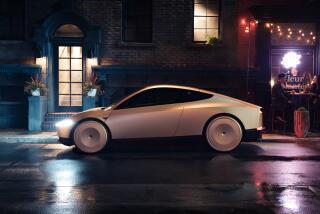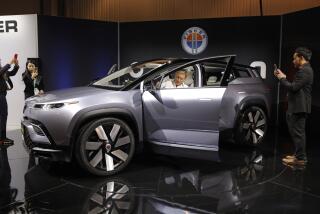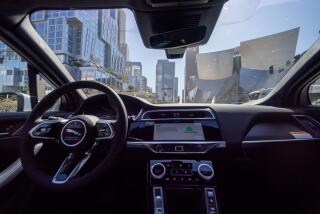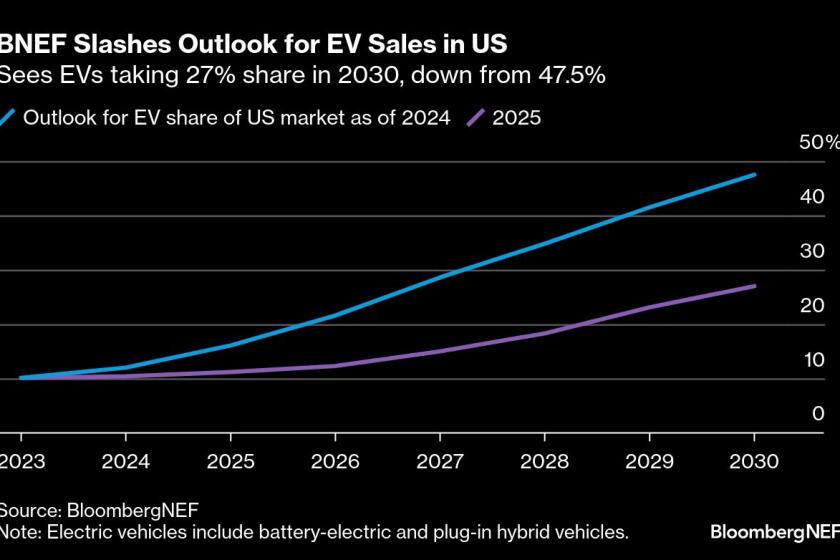The Best Is Yet to Come : Call Them ‘Concept Vehicles’ or Simply ‘Dream Cars’--With Satellite Navigation, 4-Wheel Steering, Solar Power and More, Autos of the Future Are on Display Now
- Share via
H. G. Wells was right: There are time machines.
And 19 of them are on display among the more than 600 cars, trucks, vans, race cars, limousines, specialty cars, classics and antiques glittering under the lights of the L.A. Convention Center at the 1988 Greater Los Angeles Auto Show.
Of course in this sober corporate age, they’re not called time machines. Some people may still refer to them as “dream cars,” but today they’re more commonly known as “concept vehicles.” But whatever the nomenclature, they offer a glimpse into the 21st Century for the more than 400,000 people expected at the show. (It covers an area the size of six football fields, so wear comfortable shoes.)
Showcase for New Technology
“I believe this is the largest number of concept vehicles ever to appear together at a U.S. auto show,” show director Ben Orloff said. “Not only does that say something about the importance of the show . . . it also shows that more and more manufacturers are realizing the value of building such cars. They give the companies a chance to showcase new technology while giving the public a look at what cars will be like in the future.”
Concept vehicles at the show, which runs today through Jan. 10, include the Chevrolet Aero 2003A, Oldsmobile Aerotech, Ford Bronco DM-1, Dodge Daytona X91 and Dodge Dakota convertible pickup truck, Chrysler Portofino, Pontiac Pursuit, Cadillac/PPG Allante Pace Car, Buick Regal convertible, Daihatsu TA-X 80, Isuzu COA III, and Volkswagen Scooter.
Nissan has two, the ARC-X and Jura, as does Toyota with the FXV-II and T-1 truck. And there will even be two electric-powered concept vehicles, the SolarWind and the General Motors/Hughes Aircraft-built Sunraycer.
Tomorrow’s Wizardry
Two versions of the same car, the X2S, are by Mitsubishi and Plymouth; one a convertible, the other a hard top.
And what sort of technological wizardry can we look forward to in the car of the future?
On the electronic end of things, how about a satellite navigation system that displays your exact position on a detailed electronic map and shows you how to get where you want to go? Or a magnetically coded card that replaces the ignition key, and when you insert it, the driver’s seat automatically assumes your favorite adjustment?
Maybe a sonar range-finding system that automatically maintains a safe following distance between you and the car ahead? Or electrically sensitive window glass that turns from transparent to dark-tinted with the flip of a switch?
Among the mechanical hardware that will likely be taken for granted are four-wheel drive, which is already available on many cars, along with four-wheel steering, now available on one or two new Japanese models. New small-displacement, turbocharged, multivalve, computer-controlled engines will put out tremendous horsepower while still delivering good fuel economy and low emissions.
New Brakes, Suspension
Anti-lock braking and traction-control systems will prevent dangerous skids or wheel spin when slowing down or speeding up on a wet road. And computer-controlled “active suspension” will replace conventional springs and shock absorbers with an electronic-hydraulic system that allows the car to “read” the road and adjust the ride accordingly.
Though their technical variety is almost infinite, there are basically three types of concept cars at the show: those that represent cars we’ll see in dealers’ showrooms in the next couple of years, such as the Dodge Daytona X91, Mitsubishi X2S, Ford Bronco DM-1 and Buick Regal convertible; those that are so technologically sophisticated that they are far in the future, such as the Pontiac Pursuit, Toyota FXV-II, Nissan ARC-X, Daihatsu TA-X 80 and Isuzu COA III; and those that are purely styling or engineering exercises, such as the Volkswagen Scooter, Dodge Dakota, Chevrolet Aero 2003A, Chrysler Portofino, and the SolarWind and Sunraycer electric cars.
“The Mitsubishi X2S concept car is a design inspiration for the sports specialty car to be produced in the near future,” said Yoshi Kawashima, Mitsubishi vice president.
The X2S, which was designed at the Mitsubishi styling studio in Cypress, is a two-seat sports car powered by a turbocharged 2.0-liter engine that produces about 200 horsepower. Although the concept version is front-wheel drive, the production version that will go on sale within two years will have four-wheel drive, and a price tag under $16,000.
Designed by Art Student
Another concept vehicle at the show, the Ford Bronco DM-1, was designed, under the guidance of instructor Richard Hutting, by Derek Milsap while he was a student at the Art Center College of Design in Pasadena. The project was sponsored by the Ford Motor Co., and the clay model so impressed company executives that they decided to have a full-scale version built by Concept Center California in Valencia, a design firm that consults with Ford on the trend-setting Southern California market.
The DM-1 is a multipurpose, five-passenger vehicle that incorporates such hardware as digital instrumentation, a satellite navigation system, and special window glass that changes tints with the flip of a switch.
The Chrysler Portofino was created by Chrysler Motors’ international design team, with body styling by Caggiola of Turin, Italy. The drive train and suspension are by Lamborghini (which is owned by Chrysler), and the 3.5-liter engine gives the futuristic touring sedan a top speed of more than 150 m.p.h. The Portofino features four “rotational” doors that, instead of swinging out like a conventional door, pivot upward. This feature allows for ease of entry and exit from the leather-upholstered, ergonomically-designed interior.
The Portofino is the first concept car resulting from the acquisition of Lamborghini by Chrysler, and was a smash hit when it debuted at the 1987 Frankfurt Auto Show. This is its first appearance in the United States.
Pushing the Design
The Pontiac Pursuit looks 10 years or more into the future, with such advances as electronically controlled four-wheel drive and steering, driver-adjustable suspension, anti-lock braking and traction control, satellite navigation system, fighter plane-type “heads-up” digital instrument display and a pair of televisions for rear-seat passengers.
The Pontiac Pursuit almost makes a dashboard obsolete, because all of the controls that are normally found on the dashboard are built into the steering wheel.
“The challenge was to push the design envelope as far as possible while still maintaining some element of plausibility and practicality,” said Terry Henline, chief designer of Pontiac Studio One.
Even further in the future is the technology embodied by the Sunraycer, the result of a collaboration between General Motors and Hughes Aircraft. Part concept vehicle, part race car, the Sunraycer won the World Solar Challenge in Australia by traveling almost 2,000 miles in less than 48 hours at an average speed of more than 40 m.p.h.--powered only by the sun.
The 360-pound vehicle’s 90-square-foot upper surface is covered by 7,200 solar cells, and it rides on hard rubber tires even narrower than those of a bicycle. One of the drivers, Molly Brennan, who is also a Chevrolet assistant product engineering manager, will be making an appearance at the show. (The Sunraycer was the lead vehicle in Friday’s Rose Parade.)
Just for Fun
And just so you don’t get the idea that all these concept cars take themselves too seriously, take a look at the Volkswagen Scooter, a three-wheeler, which the company bills as “Fun transportation of the future.”
Power for the 1,200-pound, front-wheel drive Scooter is provided by a standard four-cylinder engine and four-speed manual transmission, giving the car a top speed of more than 120 m.p.h. The upward-opening gull-wing doors and rear window can be easily removed to create a sort-of convertible, and the glove box is a removable attache case.
“The Scooter is a design exercise, and although there are no production plans, it is a fully functional vehicle that meets international safety standards,” said Dr. Ulrich Seiffert, head of Volkswagen’s research department. “What we wanted to do was build a vehicle that combines the fun of a sports car and a high-performance motorcycle.”
Representatives of the various manufacturers are reluctant to discuss the exact dollar amounts involved in creating a concept car. Informed sources, however, say it can range from $1 million up to tens of millions. It all depends on the technological complexity of the vehicle and whether it was intended purely for display or for actual driving.
The 66th annual Greater Los Angeles Auto Show at the L.A. Convention Center runs Jan . 2-10. Hours are noon to 11 p.m. Monday, Wednesday and Friday, 4 p.m. to 11 p.m. Tuesday and Thursday, 11 a.m. to 11 p.m. Saturdays, and 11 a.m. to 10 p.m. Sundays. Tickets are $4 for adults; children 12 and under admitted free when accompanied by an adult. For further information, call (213) 748-8531.






